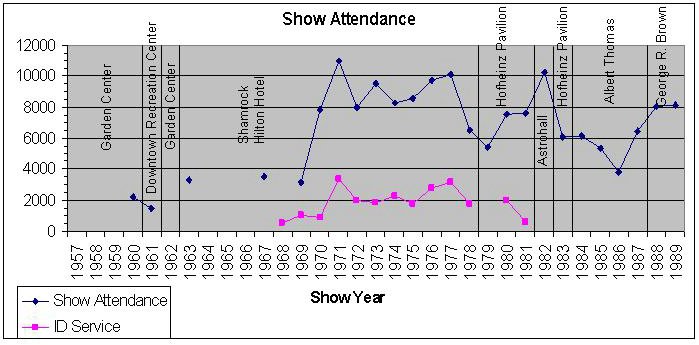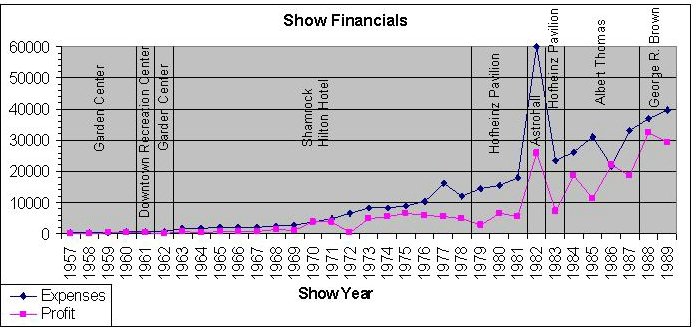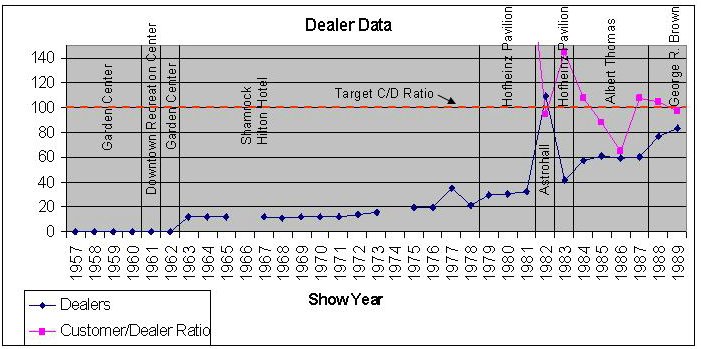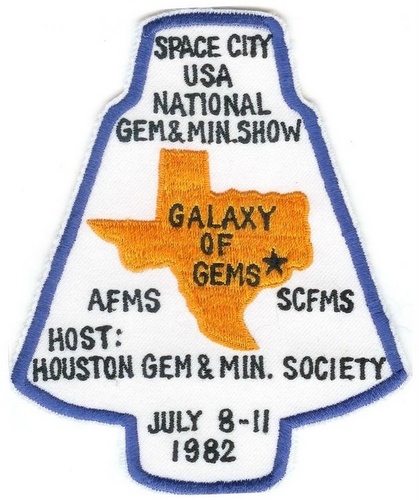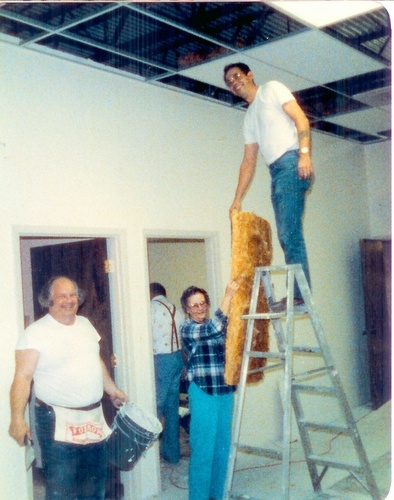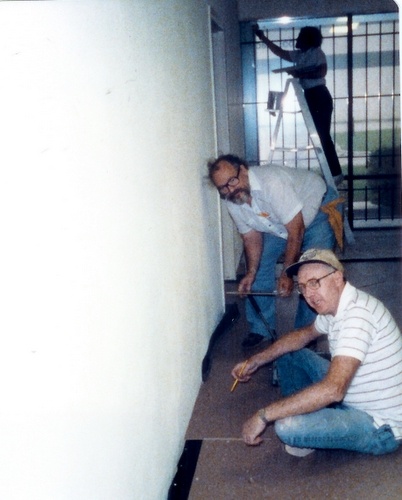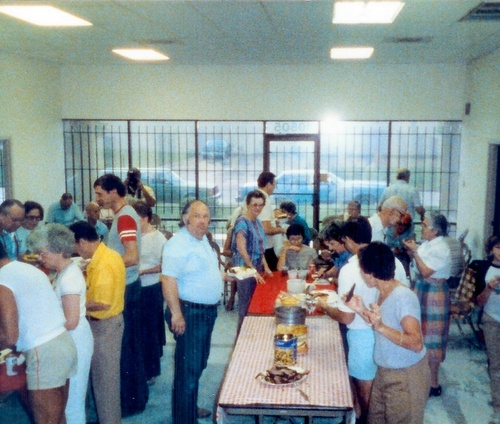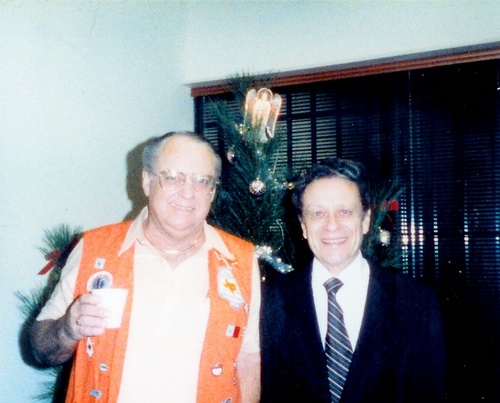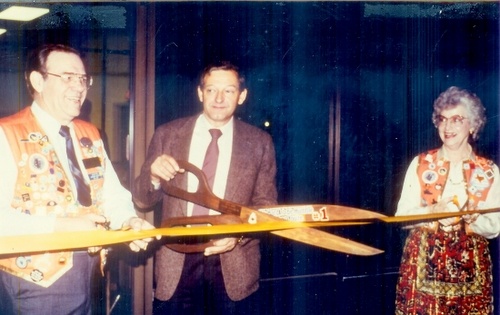Although the new clubhouse took center stage, we actually did have a show that year, although it was held in late August because the Albert Thomas management bumped us off of our normal date in early September. Interestingly, Bob Cross was the Show Chairman with Jerry Foster as his assistant. Attendance was a bit less than the previous year, but profit was way down. This was due to rapidly increasing publicity costs and also an unexpectedly high electricity bill ($3,000 higher than the previous year). This understandably caused much concern among the Board, who went back to the electrical contractor to find out if the bill was correct. It was. Because of this problem, the Board voted to add restrictions on electrical usage to the dealer contracts. (These restrictions exist to this day). This change to dealer contracts succeeded in bringing electricity usage down to a reasonable level in 1986.
1986-1989—Change in Mindset: With a new clubhouse came a new attitude. This attitude did not just materialize out of thin air, but was the result of realities on the ground. Namely, we now had a clubhouse that needed funds for survival. We had a note to pay, utility bills, insurance, and clubhouse modifications that continued for many years.
So what was this new mindset? Simply to “maximize profit.” While today we might not think this was such a big deal, remember that this was a club that previously had almost no expenses to cover and no goals to work for. They simply existed to have fun, learn new lapidary techniques, broaden their existing knowledge of minerals, fossils, and jewelry making, and to exhibit their work. Bill Cox expended a lot of effort trying to change this lack of foresight. Now it was a reality.
Of course, the clubhouse attracted the lion’s share of attention in this period. In January, President Tom Wright gave the club the choice of meeting at the new clubhouse (for the General meeting) or the Garden Center, and they chose to continue meeting at the Garden Center (the Sections by then were all meeting at the clubhouse). The General Meeting began meeting at the clubhouse in early 1987.
Also on their minds was the fact that the mortgage agreement called for a balloon payment at the end of the 10-year note. Several were concerned about this, including long-time treasurer Derry Gartig and Director (and assistant Dealer Chairman) Doug Troeder. These two proposed starting a building endowment fund that would be tax exempt. The fund would be used in 1995 to pay off the balloon payment.
The show was run by Ron Carman and Stan Madsen in both 1986 and 1987. Ed Raines and Doug Troeder were the Dealer Chairmen, with Doug being the Dealer Chairman in 1987. The primary difference with this show from the 1985 show was the issue of expenses. The concern over high electricity and publicity expenses in 1985 caused Ron to slash expenses anywhere he could. The primary victim of this slashing was publicity. Debbie Cox (Director and BBG Editor) handled publicity with the assistance of Ben Noble. Ron gave her a budget of $5,500 (substantially less than in 1985), but she only spent $2,700. Part of the problem was that all the ticket stubs from 1985 were accidentally thrown into the trash, so our mail-out database was a bit scant.
The result was a show that slashed expenses by about $9,400 over 1985 levels. This reduction in expenses went straight to the bottom line: Profit increased by about $10,400 (helped substantially by an increase in dealer fees). Unfortunately, the public did not cooperate—attendance dropped by 1500 over 1985, which had already dropped from 1984. The reasons for this are many-fold: Publicity was scant, the weather was bad with lots of rain, and oil prices crashed to $12/barrel in March from a high of $33/barrel in September of 1985, resulting in the loss of 175,000 oil-related jobs in Texas. This event is known among the oil industry as “the crash of 1986.” Layoffs were in the thousands, even tens of thousands in the larger oil companies, throughout the spring and summer. I hardly think a substantial portion of our core audience was thinking about spending money on minerals, fossils, or jewelry in early September.
1987: The primary item of business in 1987 was to find a new show location. The Albert Thomas Convention Center was slated to close as a show venue because the near-by George R. Brown Convention Center was nearing completion. The Board searched for alternate venues, eliminated the Astrohall once again due to price, and finally settled on the George R. Brown in the summer. President Dalton Prince handled the negotiations with the City of Houston, and arrived at a very favorable rate due to the fact that we are a nonprofit organization.
Also important was the fact that Yvonne Dobson once again became the publicity chairman and proceeded to arrange a large amount of exposure for the club. She and Show Chairman Stan Madsen went before the Board in June requesting an additional $3,000 to spend on a series of spots with Channel 13 (ABC affiliate). The Board agreed, and Yvonne received a total of 21 spots for her efforts. In addition, she got spots on Channel 2 (NBC affiliate), radio station KPRC, Houston Home and Garden magazine, and several public libraries. Total cost for her publicity: $12,600, almost $10,000 more than the year previous and $4,000 more than 1985.
The result of this fantastic publicity effort: An attendance that was almost double that of the previous year (6,458), which in turn resulted in a profit figure that was only $3,000 less than the artificially high 1985 level. This is actually more critical than it might first appear because not only does the club need to make an adequate amount of profit, but each of the 60 dealers in our show also needs to be kept happy. And they will be kept happy as long as the customer-to-dealer ratio is at an acceptable level (100+), which it was due to the increase in attendance (108).
1988-1989—New Venue (again): As the year started out, the club was continuing to think of ways to make money because it had its eye on the 1995 balloon payment for the clubhouse. The Building Endowment Fund was being promoted as a way to build up a reserve cash supply. In addition, the club decided that what it really needed was another National Show just like its last one. Thus, the Board voted in January to make a bid for the next one (one was being hosted this year by the SCFMS in Shreveport, LA). So Bill Cox was approached to talk to the AFMS and see if we could put in a bid. The AFMS agreed, and the bid was accepted at the SCFMS show in August. And the year was convenient also: 1994 was just one year prior to the due date of our balloon payment.
As an added benefit, our move to the George R Brown enabled us to add even more dealers to the show (read: make more money). Dealer Chairman Ruth Hammett had 77 dealers in 1988 and 83 dealers in 1989. But as I have discussed before, basic economic principles dictate that a rise in number of dealers necessarily means that more attendees are required in order to keep the customer-to-dealer ratio at optimal levels. Thus, Publicity Chairman Yvonne Dobson needed to work her usual wonders. The Board approved giving her $13,000, slightly more than she used in 1987, with which to work these wonders. She did not disappoint either: Show attendance was increased by 1,600 over 1987, totaling 8,061. These attendance figures were back to the great numbers seen in the 1970s. The difference was that with 77 dealers, the customer-to-dealer ratio was at an optimal 105, unlike in the 1970s when it was 300–600.
The other major show-related event of 1988 was the reinstatement of the Swap Area. It had been killed by the Board, over the protests of the Mineral Section, in late 1986 because of a variety of complaints from dealers as well as club members. But in February Tim Smith presented the Board with a revised set of rules governing Swap Area use and volunteered to be the Swap Area Chairman. All the usual complaints were aired at this meeting and were rebutted by Tim using a document prepared by the Mineral Section. Complaints were centered on a perceived competition with dealers, perceived exclusive use by the Mineral Section, the location within the show interfering with dealers, and a lack of effective leadership to run the booth.
Tim’s rebuttal stated that the Swap Area is in competition with dealers, but the money gets recycled back to the dealers’ pockets because all purchases must be made in swap dollars which, in turn, can only be spent with dealers. Exclusive use by the Mineral Section stems from the prohibition of selling finished jewelry. (The reason given had something to do with tax liability, which I am still unclear about). But regardless, faceted or rough stones, polished or unpolished cut material, and fossils can all be sold in the Swap Area. Location was a problem at various times in the past, but became a non-issue because the George R. Brown had so much space that it could be located in the back well away from dealers. With Tim’s assurances of effective leadership by himself, the Board somewhat reluctantly agreed to reinstate the Swap Area for the 1988 show.
The other potential issue beginning to surface was that the show was now becoming so complex and such a large effort that nobody wanted to take leadership positions on the Show Committee. (Sound familiar? It should because the situation has not changed to this day.) Ron Carman was the only person who would volunteer, as he had for the past two years (along with Stan Madsen), and thus he got stuck with the job in both 1988 and 1989. And he did it by himself—nobody would even volunteer to be Co-chairman (sound familiar?), although they managed to get Ben Noble to volunteer to help with the Assistant position in 1989 with the proviso that he would not be required to take the Chairman position the following year (again, sound familiar?).
So, the 1989 show was almost a carbon copy of the 1988 show, which is not a bad thing: Attendance of 8,100 with 83 dealers, producing a customer-to-dealer ratio of a picture-perfect 98, profit of $30,000 and a profit margin of 74%. There’s not an organization in the world that would hesitate even a second before proclaiming this an enviously successful show.
But the issues facing our club needed to be addressed because they would not simply vanish into thin air: Attendance was not very good at the General Meetings now being held at the new clubhouse in 1987 after 24 years at the Garden Center. Ron Carman was not the “Show Committee Chairman for life,” so other volunteer leaders would need to step forward. There was still a balloon payment due in 1995 that the club was not making much progress toward meeting despite their much touted Building Endowment Fund. In addition, Yvonne Dobson’s valuable experience in the publicity field was effectively lost following the 1989 show because of disagreements on how to handle the show mailing list (in those days computers were still a novelty, and Microsoft database managers were not as ubiquitous as they are now).
And to cap it all off, Herb Duke brought a third Intergem show into the Houston market in 1989. His shows were now in January, May, and November. While this was still not directly interfering with the run-up to our show, it nevertheless was definitely taking a progressively larger share of the dollars available for jewelry sales. Plus it was becoming even more difficult for the public to tell the two shows apart; a problem that would only grow worse in the coming decade.
Epilogue: In looking at this decade, it is an indisputable fact that the two most important events in the life of our club, even to this day, occurred. First, we held our first National Show in 1982. Because of the vision and financial wisdom of Bill Cox, this show was outrageously successful and earned us national accolades. It didn’t hurt that Bill was then a sitting officer on the AFMS (the nationwide American Federation) Board. Conversely, I’m sure the success of that show didn’t hurt his reputation, which would culminate as AFMS President in 1984. The success of that show was such that it produced a profit that was about four times our normal show profit. In addition, this profit would represent a little less than half of the total financial holdings of the club at the time we purchased our clubhouse.
Which brings us to the second most important event in the life of our club—the purchase of a clubhouse in 1985. To this day, there are only three clubs in Texas that have their own clubhouse (Arlington, Austin, and us), so I cannot emphasize enough the importance of this. It allows us to have a building of our own that houses a meeting room, shop, classroom, library, kitchen, offices, and storage. Imagine how difficult our job would be as a club if we didn’t have our clubhouse. Only after you fully visualize not having a clubhouse can you appreciate how much we can, and are, doing because we have a clubhouse.
Despite the various problems and headaches involved in putting on a large and complex show such as had evolved by that time (by a volunteer club, I might add), the shows produced during this era were “by the book” as far as show economics were concerned. The entire goal in producing a show is to put on the best show the organization is capable of, so as to attract the maximum number of attendees, and then stock the show with however many retail vendors that can be kept happy by the number of attendees. That dealer number is easy to calculate—the target customer-to-dealer ratio is approximately 100. This approximate C/D ratio was held throughout most of the decade.
In general, the club at this time did the best it could with the resources it had available to it, and the results were quite impressive.
Acknowledgements: Numerous current and former club members contributed to this article. I thank the following individuals for their extensive help: Art Smith, Ron Carman, Yvonne Dobson, Bill Cox, Derry Gartig, Tom Wright, Steve Blyskal, Irene Offeman, Tom DeHart, Anne Frank, and Tim Smith. Even though I did not speak to them personally, I am indebted to the contributions of JoAnn Gartig for her compilation of attendance records through the 1980s and Frances Harris for her immaculate minutes of Board meetings from 1977–1980 and 1982, and her similarly immaculate records of all National Show Committee meetings in 1981 and 1982.

